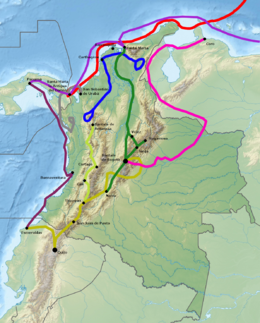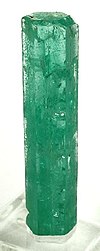Gonzalo Jiménez de Quesada
[5] He was appointed chief magistrate in 1535 and second in command for an expedition to present-day Colombia, because in that period he was not in good standing with the people at home because he had just lost an important court case in which his mother's family was economically involved.
[6] The commander of the expedition, Pedro Fernández de Lugo (governor of the Canary Islands), had bought the governorship of Santa Marta and had equipped a fleet and assembled over a thousand men.
But when, after two month of navigation, they reached the small coastal settlement of Santa Marta, all they found was a conglomeration of hovels and filthy, disease-ridden colonists who went about dressed in skins or roughly woven and padded cotton clothes made by the natives from surrounding areas.
A land party under De Quesada, with Hernán Pérez de Quesada (his brother), Juan San Martín, Juan del Junco (as second in command) Lázaro Fonte and Sergio Bustillo, struck south from Santa Marta, crossed the Cesar River, and arrived at Tamalameque on the Magdalena River.
Only 180 men out of 800 survived, suffering terribly in the jungle: they were forced to eat snakes, lizards, frogs, and even the leather torn from their harnesses and the scabbards of their swords.
They chose a spot next to the towering peaks of the east, where the land was high and the rains would quickly run off, where the mountains would protect them from attackers and the jungles below.
Quesada placed his right foot on the bare earth and said simply, "I take possession of this land in the name of the most sovereign emperor, Charles V." Quesada remained in the region until the arrival of two expeditions at the end of 1538: Sebastián de Belalcázar from Quito, modern-day capital of Ecuador, one of the captains of Pizarro who had mutinied against his leader; and Nikolaus Federmann, a German from Venezuela.
In order to resolve their dispute, De Quesada persuaded them to go back to Spain with him and to submit their rival territorial claims to the arbitration of the crown.
From Bogotá in April 1569 with 500 mounted soldiers, 1500 natives, 1100 horses and pack animals, 600 head of cattle, 800 pigs, a large number of negro slaves and 8 priests, he first descended to Mesetas on the upper Guejar River.
After a brief period of service in a frontier command (during which he suppressed an indigenous uprising) De Quesada, affected by leprosy, overcome with despair at his debts, owing more than 60 thousand ducats, was forced to seek a milder climate and died quietly, aged 70, in Mariquita, an important market town in the New Kingdom of Granada.

Green is De Quesada's approximate trajectory
Note: route around the Sierra Nevada de Santa Marta incorrectly drawn
